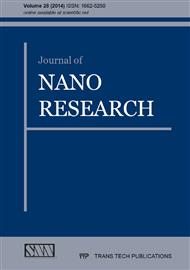[1]
W. Prellier, A. Fouchet, B. Mercey, Oxide-diluted magnetic semiconductors: a review of the experimental status, J. Phys.: Condens. Matter 15 (2003) R1583-R1601.
DOI: 10.1088/0953-8984/15/37/r01
Google Scholar
[2]
S. Ostanin, A. Ernst, L.M. Sandratskii, P. Bruno, M. Däne, I.D. Hughes, J.B. Staunton, W. Hergert, I. Mertig, J. Kudrnovský, Mn-stabilized zirconia: from imitation diamonds to a new potential high-TC ferromagnetic spintronics material, Phys. Rev. Lett. 98 (2007) 016101-1-4.
DOI: 10.1103/physrevlett.98.016101
Google Scholar
[3]
C. Clavero, G. Armelles, J. Margueritat, J. Gonzalo, M. García del Muro, A. Labarta, X. Batlle, Interface effects in the magneto-optical properties of Co nanoparticles in dielectric matrix, Appl. Phys. Lett. 90 (2007) 182506-1-3.
DOI: 10.1063/1.2737126
Google Scholar
[4]
T. Archer, C.D. Pemmaraju, S. Sanvito, Magnetic properties of ZrO2-diluted magnetic semiconductors, J. Magn. Magn. Mater. 316 (2007) e188-e190.
DOI: 10.1016/j.jmmm.2007.02.085
Google Scholar
[5]
P. Che, W. Liu, L. Guo, L. He, C. Chen, High-temperature ferromagnetism in cobalt-doped ZnO single-crystalline nanorods, J. Magn. Magn. Mater. 320 (2008) 2563-2566.
DOI: 10.1016/j.jmmm.2008.03.047
Google Scholar
[6]
S. Hirano, M. Yoshinaka, K. Hirota, O. Yamaguchi, Formation, characterization, and hot isostatic pressing of Cr2O3-doped ZrO2 (0.3 mol% Y2O3) prepared by hydrazine method, J. Am. Ceram. Soc. 79 (1996) 171-176.
DOI: 10.1111/j.1151-2916.1996.tb07895.x
Google Scholar
[7]
S. Ram, Synthesis and structural and optical properties of metastable ZrO2 nanoparticles with intergranular Cr3+/Cr4+ doping and grain surface modification, J. Mater. Sci. 38 (2003) 643-655.
Google Scholar
[8]
G. Štefanić, S. Musić, A. Gajović, Thermal behavior of the amorphous precursors in the ZrO2-CrO1.5 system, J. Mol. Struct. 744–747 (2005) 541-549.
DOI: 10.1016/j.molstruc.2004.10.076
Google Scholar
[9]
M. Rabe, J. Dreßen, D. Dahmen, J. Pommer, H. Stahl, U. Rüdiger, G. Güntherodt, S. Senz, D. Hesse, Preparation and characterization of thin ferromagnetic CrO2 films for applications in magnetoelectronics, J. Magn. Magn. Mater. 211 (2000) 314–319.
DOI: 10.1016/s0304-8853(99)00753-2
Google Scholar
[10]
A. Bajpai, A.K. Nigam, Synthesis of high-purity samples of CrO2 by a simple route, Appl. Phys. Lett. 87 (2005) 222502-1-3.
DOI: 10.1063/1.2136411
Google Scholar
[11]
S. Ram, S. Biswas, H.-J. Fecht, Advanced ceramics and nanocomposites of half-metallic ferromagnetic CrO2 for magnetic, GMR and optical sensors, in: S. Seal (Ed.), Functional Nanostructures: Processing, Characterization, and Applications, Springer Science+Business Media, LLC, New York, 2008, pp.1-53.
DOI: 10.1007/978-0-387-48805-9_1
Google Scholar
[12]
H.H.B. Rocha, F.N.A. Freire, R.C.S. Costa, R.S.T.M. Sohn, G. Orjubin, C. Junqueira, T. Cordaro, A.S.B. Sombra, Dielectric resonator antenna: operation of the magnetodielectric composites Cr0.75Fe1.25O3 (CRFO)/Fe0.5Cu0.75Tl0.75O3 (FCTO), Microwave Opt. Technol. Lett. 49 (2007) 409-413.
DOI: 10.1002/mop.22160
Google Scholar
[13]
G. Lawes, T. Kimura, C.M. Varma, M.A. Subramanian, N. Rogado, R.J. Cava, A.P. Ramirez, Magnetodielectric effects at magnetic ordering transitions, Prog. Solid State Chem. 37 (2009) 40-54.
DOI: 10.1016/j.progsolidstchem.2009.08.001
Google Scholar
[14]
Powder Diffraction File JCPDS (Joint committee on powder diffraction standards), International centre for diffraction data, Swarthmore, PA (1999) Card 49-1642.
DOI: 10.1017/s0885715600019291
Google Scholar
[15]
G. Morell, R.S. Katiyar, D. Torres, S.E. Paje, J. Llopis, Raman scattering study of thermally reduced stabilized cubic zirconia, J. Appl. Phys. 81 (1997) 2830-2834.
DOI: 10.1063/1.363941
Google Scholar
[16]
W. Araki, T. Koshikawa, A. Yamaji, T. Adachi, Degradation mechanism of scandia-stabilised zirconia electrolytes: Discussion based on annealing effects on mechanical strength, ionic conductivity, and Raman spectrum, Solid State Ionics 180 (2009) 1484-1489.
DOI: 10.1016/j.ssi.2009.09.001
Google Scholar
[17]
R. Srivastava, L.L. Chase, Raman spectra of CrO2 and MoO2 single crystals, Solid State Comm. 11 (1972) 349-353.
DOI: 10.1016/0038-1098(72)90247-5
Google Scholar
[18]
C.H. Lin, S.Y. Chen, N.J. Ho, D. Gan, P. Shen, Shape-dependent local internal stress of a-Cr2O3 nanocrystal fabricated by pulsed laser ablation, J. Phys. Chem. Solids 70 (2009) 1505-1510.
DOI: 10.1016/j.jpcs.2009.09.015
Google Scholar
[19]
T.J. Dines, S. Inglis, Raman spectroscopic study of supported chromium(VI) oxide catalysts, Phys. Chem. Chem. Phys. 5 (2003) 1320-1328.
DOI: 10.1039/b211857b
Google Scholar
[20]
J.A. Bearden, X-ray wavelengths, Rev. Mod. Phys. 39 (1967) 78-124.
Google Scholar
[21]
K. Zafar, P. Audehm, G. Schütz, E. Goering, M. Pathak, K.B. Chetry, P.R. LeClair, A. Gupta, Cr magnetization reversal at the CrO2/RuO2 interface: origin of the reduced GMR effect, Phys. Rev. B 84 (2011) 134412-1–6.
DOI: 10.1103/physrevb.84.134412
Google Scholar


